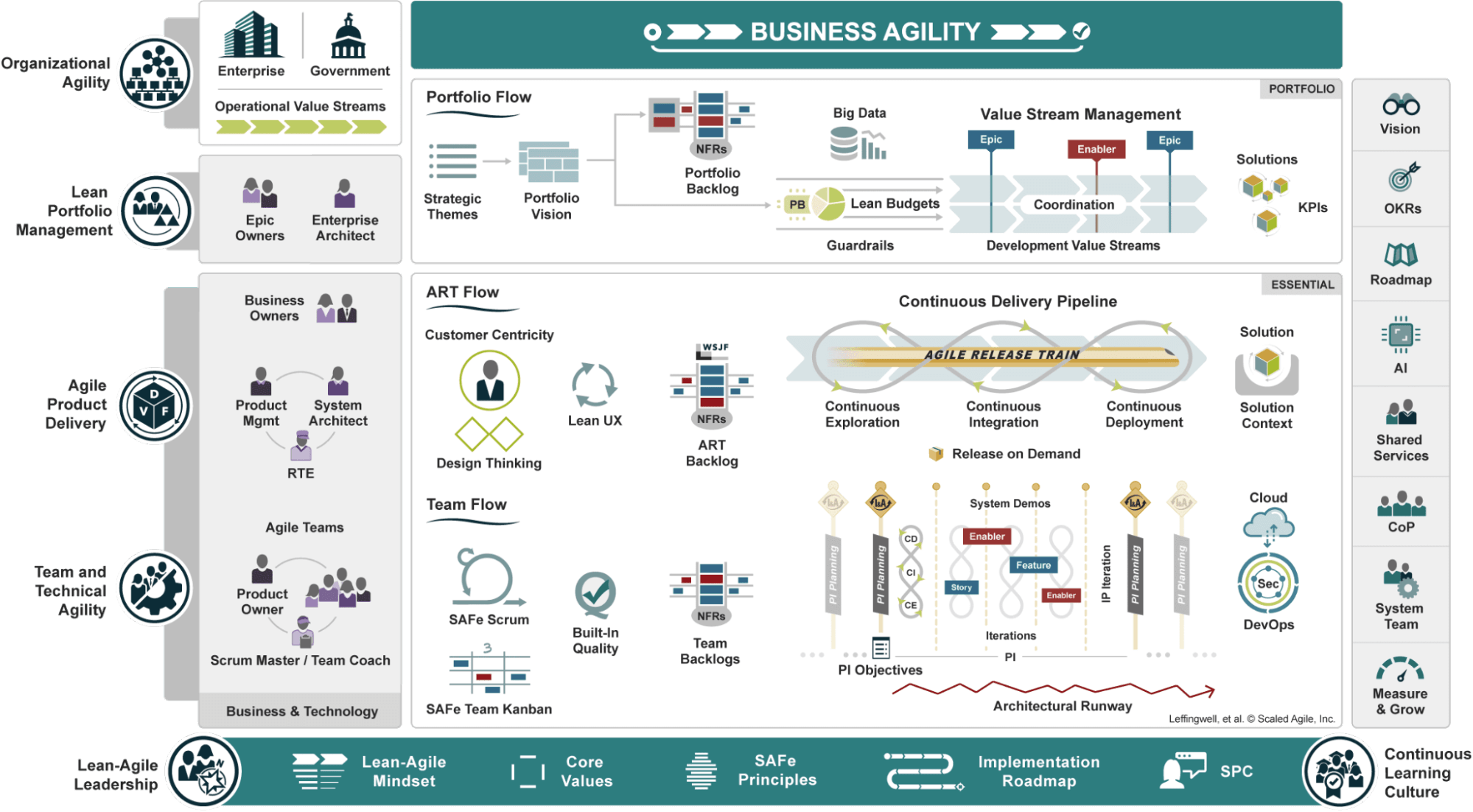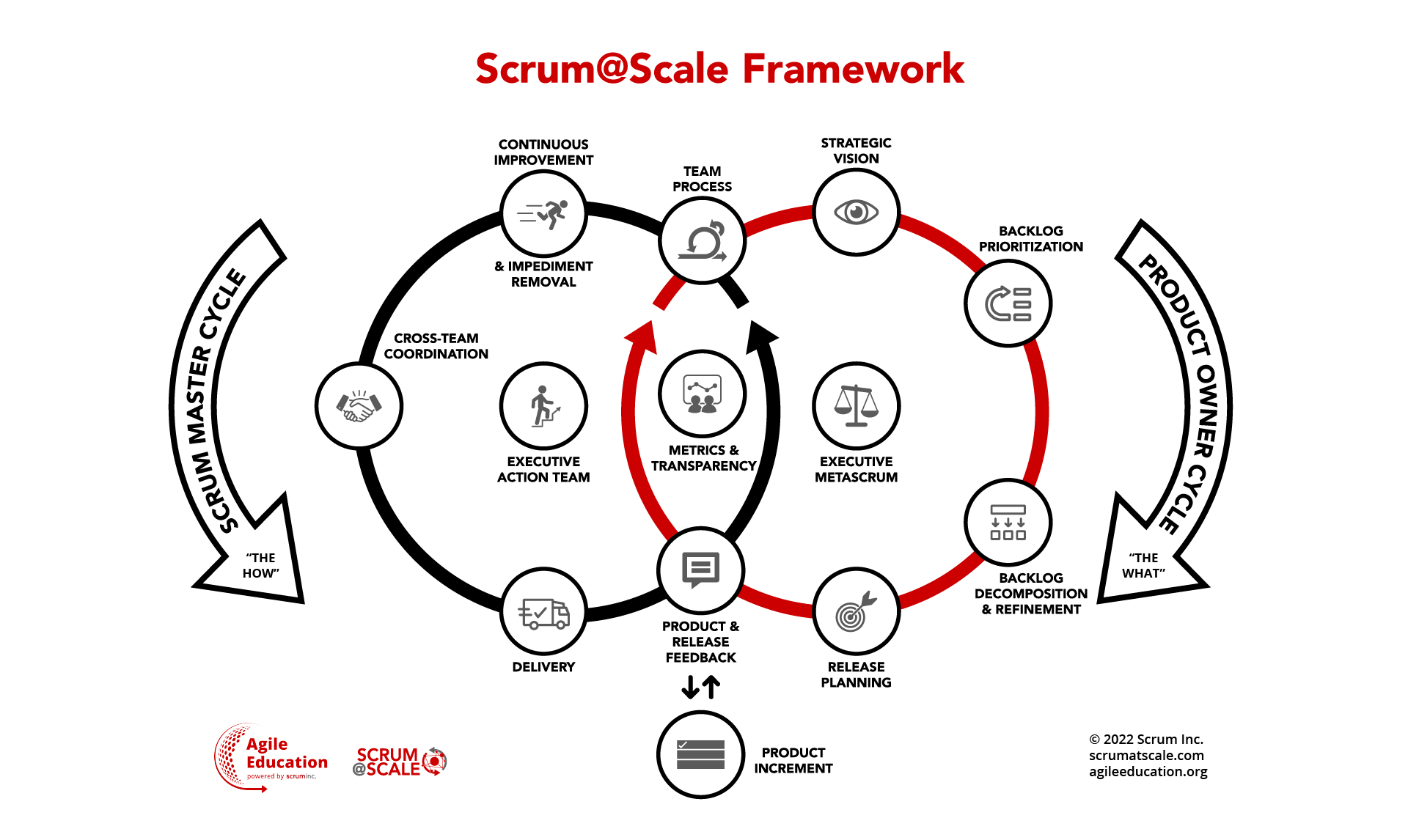Agile is a term that gets thrown around a lot in today's business world, but what does the Agile Methodology mean, and what can it do for your company?
Depending on who you ask, it's either the "new standard" for project management — a much more efficient way to do things that speed up projects and cut waste — or a narrow project management method only useful in software and tech.
So which is it? And can it help you? In this guide, we'll explain exactly what the Agile methodology is and how it's changed in 2023. We'll cover its principles, benefits, popular frameworks, and more. We'll also explain how to determine if Agile project management suits you.
What is the Agile methodology, and how has it changed?
The Agile methodology is a set of principles and practices that focus on the continuous delivery of value to customers (quickly and efficiently).
Agile project management is based on the idea of an iterative development process, which means that teams work in short cycles to provide incremental improvements in a product or service.
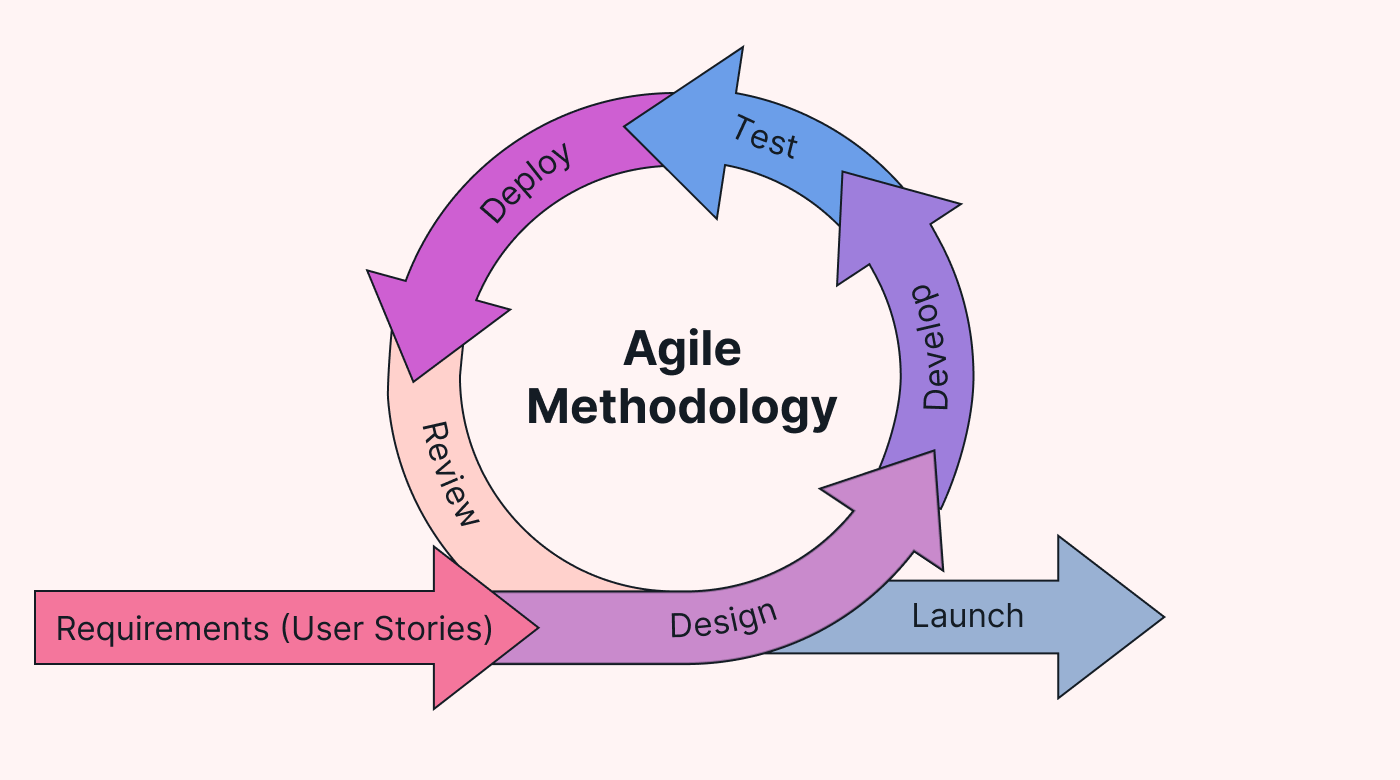 |
This approach allows teams to respond quickly to customer feedback and make changes as needed instead of dogmatically “sticking to the plan.”
The Agile movement started in 2001 through a team of software developers releasing the “Agile Manifesto.”
This document laid out 12 principles that describe their ideal approach to software development projects, from satisfying the customer (delivering continuous, incremental versions) to regularly reflecting on improving efficiency. To read more about Agile Principles, read our guide to the Agile Manifesto.
The easiest way to understand the spirit of Agile is to understand the pillars or core values behind these principles.
What are the 4 pillars of Agile?
The four pillars showcase what an Agile team should value.
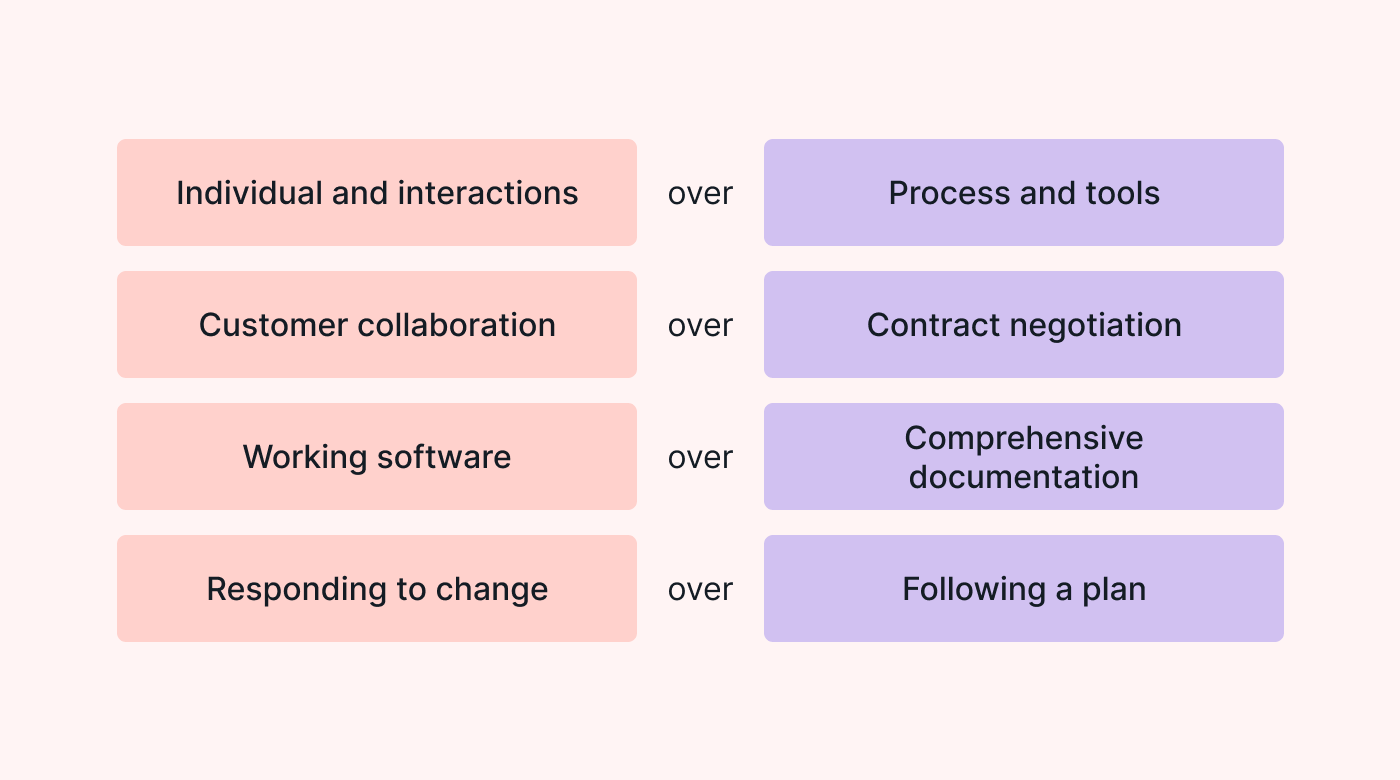 |
- Individuals and interactions over processes and tools. In Agile approaches like Scrum and Kanban, there’s a focus on democratization. Every team member gets a say. They get heard. To ensure this, Agile organizations hold plenty of informal meetings, typically daily, to uncover any impediments to a person’s progress.
- Customer collaboration over contract negotiation. By making customers active stakeholders in a project, you can ensure the results match their actual needs rather than their expectations at the outset.
- Working software over comprehensive documentation. You focus on progress in terms of features or deliverables rather than investing months in creating a work breakdown structure and detailed project plan.
- Responding to change over following a plan. Changes in scope, environment, budget, client priorities, and more inherently affect projects. In Agile, you accept this and focus on adapting rather than pretending you know it all upfront.
The focus is specifically on software here (since software developers wrote the Agile Manifesto), but, the approach has since evolved to encompass a wide variety of projects and industries.
How has Agile changed since the Agile Manifesto?
When it first hit the project management scene, Agile was intrinsically tied to software development.
And it makes sense. Kent Beck, one of the founders of Agile, had previously developed Extreme Programming to help a development team at Chrysler create a unified payroll application. The Agile Manifesto in 2001 came only two years after he released a book on Extreme Programming.
So, most of the early dialogue and advice was centered around “the development team,” “development cycles,” and “feature-driven development.”
Over the past decade, however, the dialogue has shifted. Project managers and business owners have seen the value of a more Agile approach in a wide range of industries.
And the goalposts have changed. Today, companies often aim to “become more Agile” — to adopt Agile principles throughout the entire organization, not just a single team.
One of the key drivers of this change is the increased impact of software and technology across roles and teams. Who today can say that they have a job where technology isn’t involved? Virtually nobody.
So, increasingly, companies want to use Agile practices to oversee their “digital transformation” — 87% of companies in a 2022 survey had this aim.
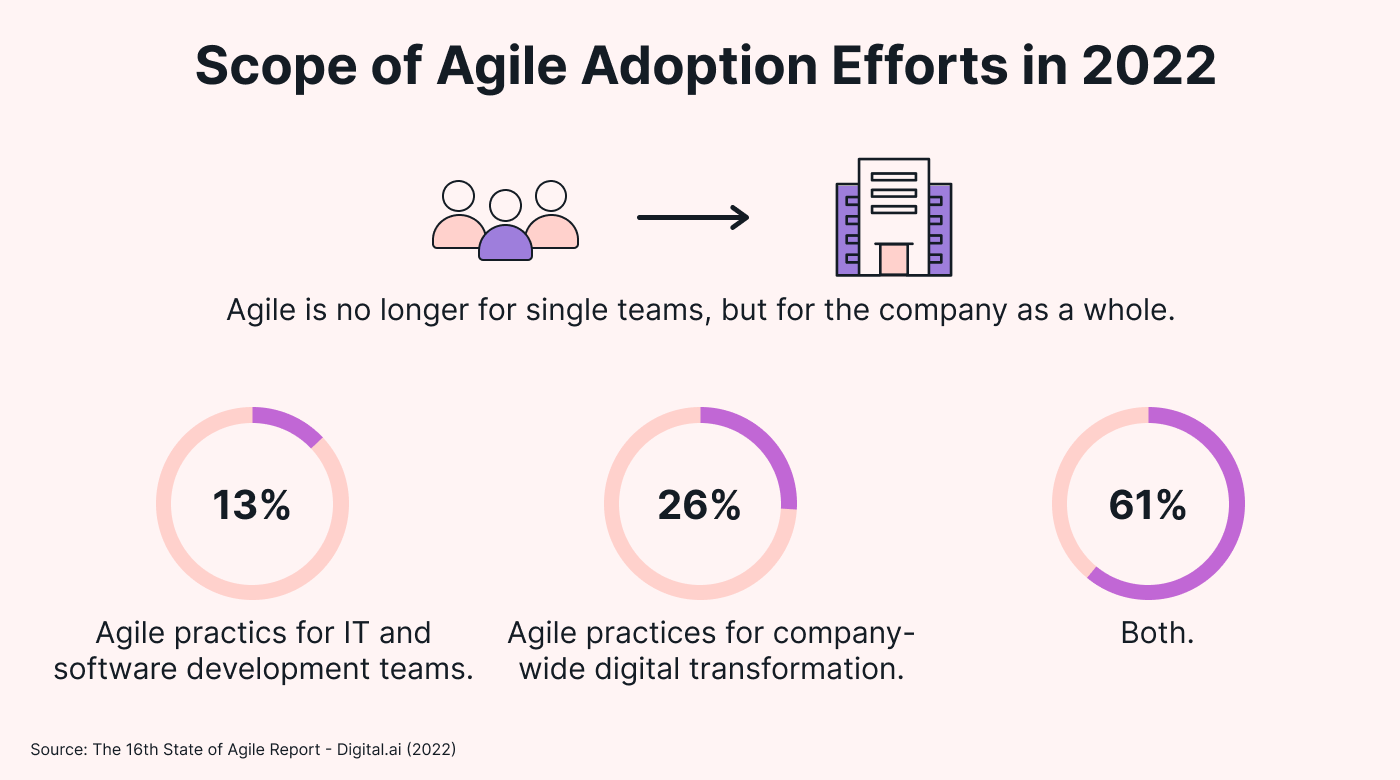 |
That is, to embed technology and data into every stage and process, including fieldwork, logistics, and more.
However, Agile is still simultaneously a methodology for managing single projects. (We know it’s confusing, but it’s only a difference in the scope of applying the Agile principles.)
But where’d this obsession come from? What makes Agile so desirable for companies globally?
What are the benefits of Agile?
Using Agile project management comes with a wide range of benefits, like better collaboration and a clearer focus on customer value.
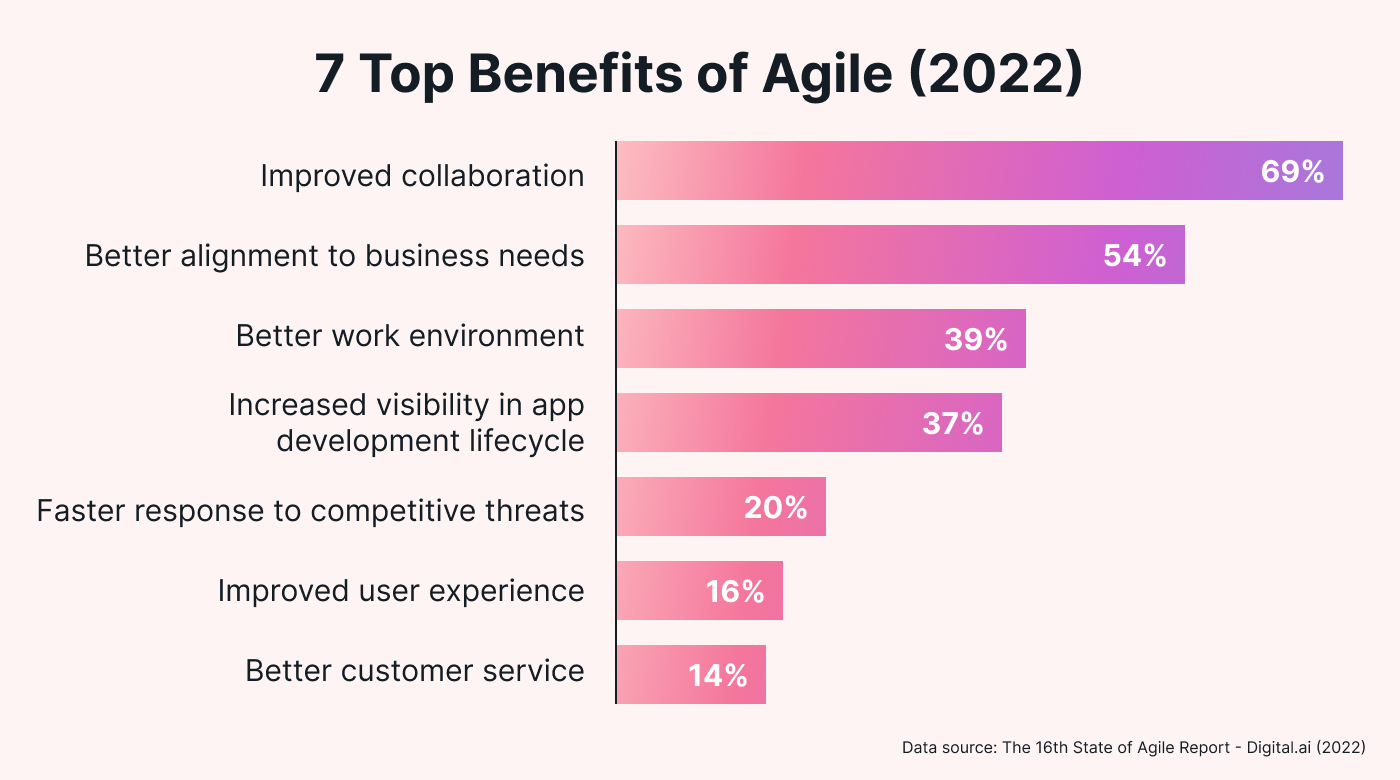 |
Better collaboration and communication = faster progress and more flexibility
Agile promotes better communication between team members, which can lead to better problem-solving and faster decision-making.
How exactly does it do this? It creates a culture of frequent, democratic meetings between your project team members.
For example, in the Agile framework Scrum, you hold daily standup meetings — the daily Scrum — typically at the start of each day. With input from everyone on their status, you can quickly identify delays impeding progress — like a supplier being behind schedule.
Better customer communication = more customer value and business alignment
In Agile, you typically include end customers in the process as key stakeholders in the project. That means you give them a chance — early and often — to see what your team is building and give their input.
This involvement helps your team stay aligned with what the customer needs and deliver more value.
Agile helps teams stay organized and on track
By breaking down large project goals into smaller chunks, teams can better manage their workload and prioritize tasks. It helps teams stay on top of deadlines and ensures that tasks are completed on time.
Agile helps teams focus on completing one task at a time. This allows teams to stay focused and eliminates the need for multitasking, which can lead to mistakes, context switching, and wasted time.
How to know if Agile is right for your team or company
When trying to understand if Agile is right for you, it often helps to compare Agile vs. the waterfall methodology.
Waterfall is the traditional approach to project management, where you start by creating a comprehensive plan. It includes every project requirement, task, and every last dollar in the project budget.
Agile, on the other hand, is more comfortable with change and the unknown.
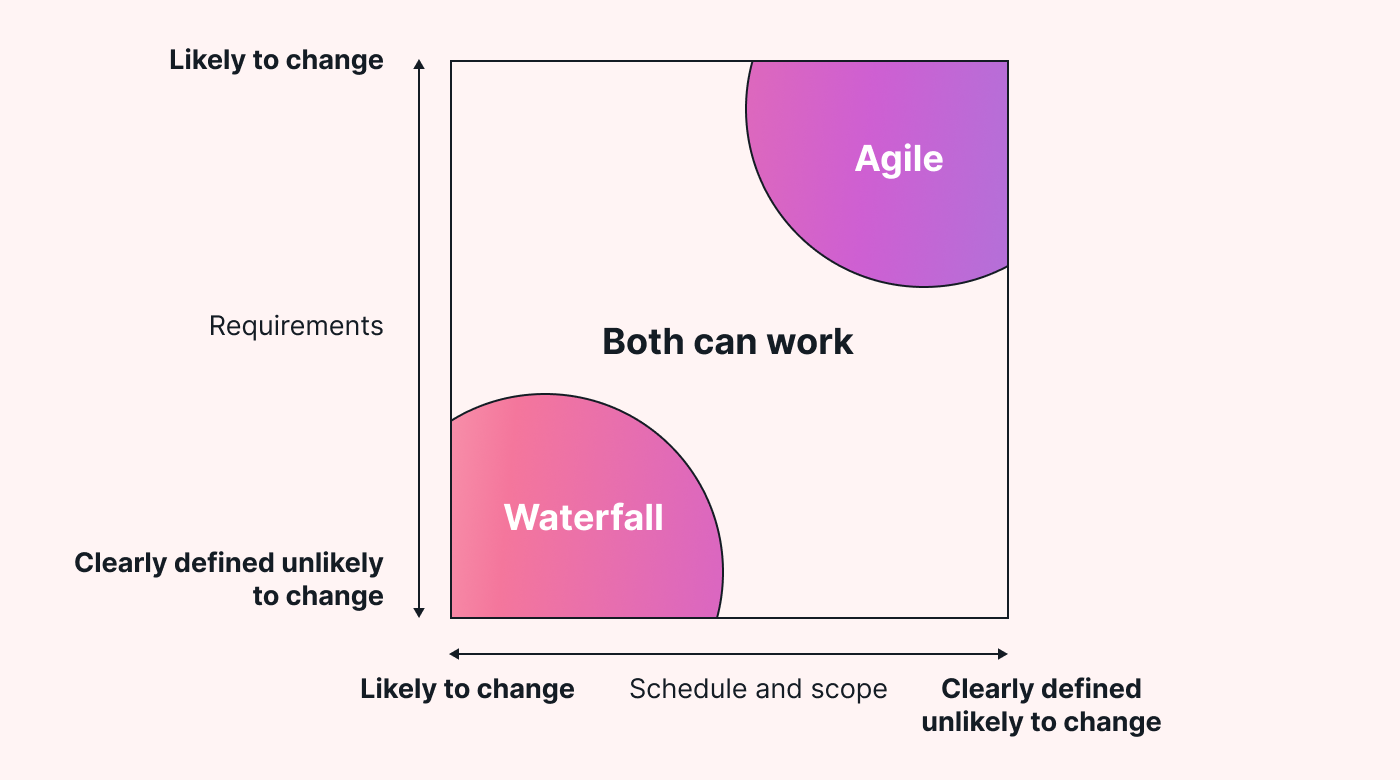 |
So here are a few factors that’d make Agile a solid choice for a project:
Lack of a clearly defined scope
Agile is usually a good choice if you’re starting a project where you have no good way of knowing the scope.
For example, let’s say you’re trying to create an innovative product with no clear parallels. How can you know how long user experience testing will take? How can you know how easy it’ll be to find manufacturers and suppliers?
You simply can’t. That’s what makes Agile methods a good fit here.
Scope or requirements likely to change
Let’s say you have a clear idea of what you want to create, but know this can change significantly over time. For example, if you’re working closely with your end customers or the industry is rapidly changing.
A good example of this is Netflix — it spent a lot of time and money developing a mail-order movie rental service. But it quickly pivoted to online streaming as customer needs and technology changed.
Agile is an excellent choice for developing a new product or service in shifting waters.
No iron-clad timeline and dependencies
Agile isn’t a good fit if you know your project’s requirements, strict timeline, and task dependencies.
A construction project in an already-surveyed area — like replacing an office building — is a good example. Small autonomous teams make little sense since you’re working in a chain of dependent tasks — laying rebar and pouring concrete. For it to go smoothly, you must follow a set schedule — there’s no room for agility.
Your team members thrive when allowed to self-manage
Your team members are the last (but certainly not least) variable here.
Agile is a natural fit if your team members are allergic to micromanagement and love to take initiative.
If your team members are inexperienced or struggle to work without directions, going fully Agile may not be the best choice.
(But you can still adapt some Agile principles into your management process without entirely sticking to an Agile framework like Scrum.)
Most popular Agile frameworks and their key differences
Now that you know the main benefits of Agile and whether it’s right for you, let’s look at which frameworks might be best.
Single projects: Scrum and Kanban
First, let’s look at Agile frameworks you can use for a single project and team: Scrum and Kanban.
Scrum: a highly structured iterative approach with small teams
Scrum is an Agile framework that focuses on frequent delivery by dividing larger projects into “sprints” lasting 1–4 weeks. During these sprints, you concentrate on features or milestones from your “product backlog” — a list of specific requirements for the finished project.
To start a sprint, your Scrum team will meet, prioritize “user stories” from the product backlog — features from the user’s perspective — and divide responsibilities.
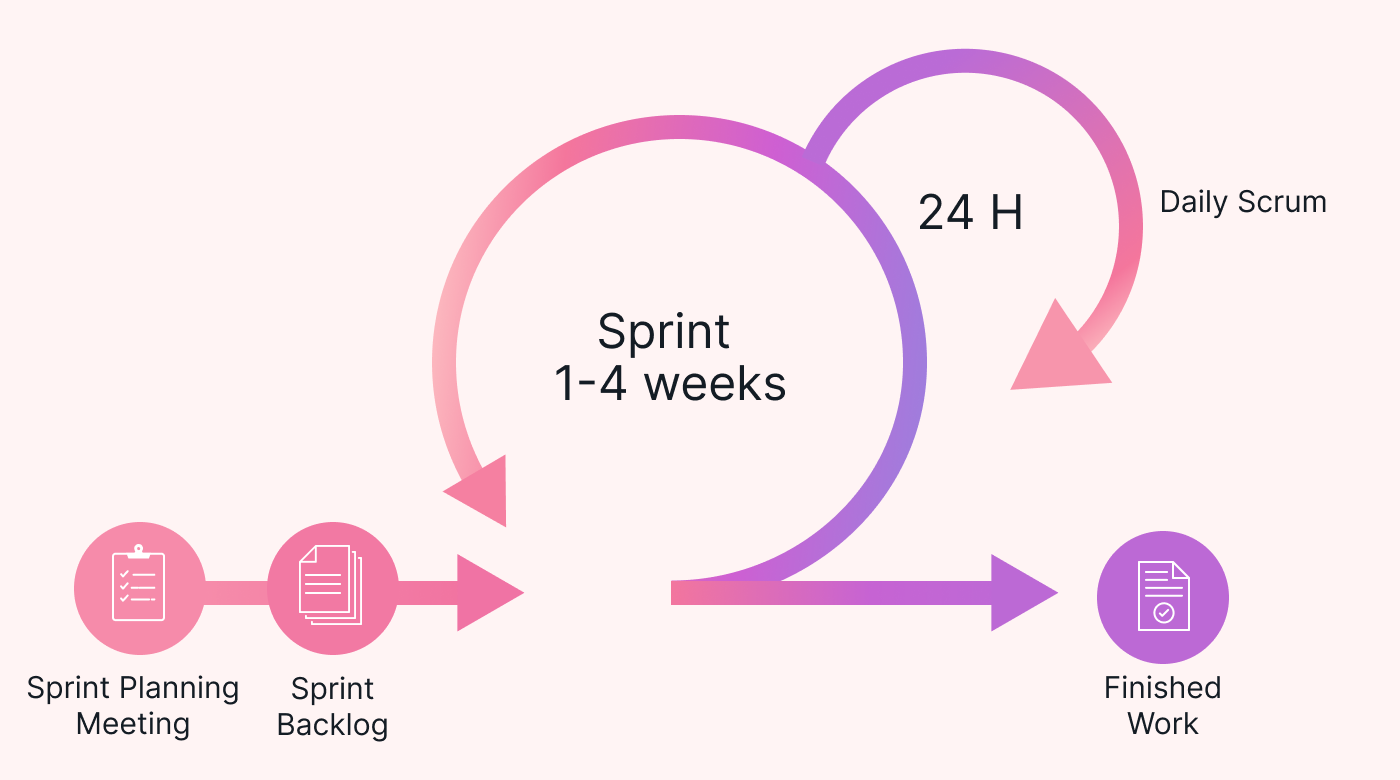 |
The project team size is limited to a recommended maximum of nine members with clear roles:
- The product owner is responsible for the product backlog and overall direction.
- The Scrum master manages the Scrum process, removes roadblocks, and makes sure the team sticks to Agile practices.
- Development team — everyone else who directly works on the product.
Kanban: a less structured framework for continual improvement
The Kanban framework is a lot looser. There are no set time frames, specific roles, or max team sizes.
In Kanban, your project team will work together to create a Kanban board — a task board with four categories: to do, in progress, in review, and done. In regular meetings, your project team will prioritize tasks from the to-do list to tackle.
Kanban promotes effective two-way communication (not just top-down orders). The Kanban cadence is a recommended schedule of meetings to help facilitate this in your company. It includes the daily standup meeting, delivery planning meeting, and five more meeting types.
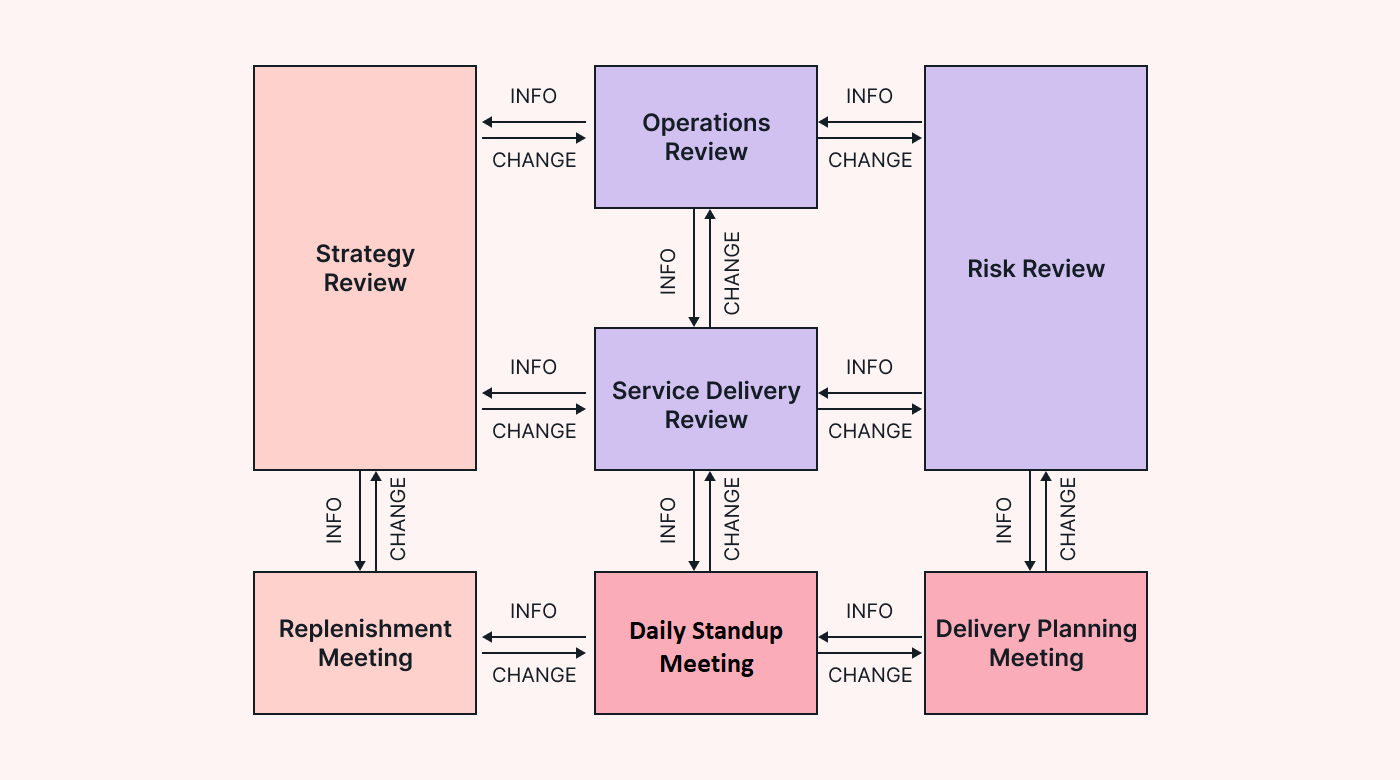 |
For more details on Kanban ceremonies, read our guide to the Kanban cadence.
Still trying to decide which to choose for your project? Read our guide on Kanban vs. Scrum.
Multiple projects: Scalable Agile Framework (SAFe) and Scrum@Scale
Remember, Agile is no longer just about single projects. Many companies now strive to apply Agile principles like flexibility, an iterative approach, and customer satisfaction across their organizations.
The Scalable Agile Framework (SAFe) and Scrum@Scale (aka Scrum of Scrums) are the two most popular frameworks.
Scalable Agile Framework: a comprehensive system for making your firm more Agile
SAFe is a comprehensive framework for scaling the spirit of Agile to your whole company. It includes high-level decision-making like overall strategy. It’s designed to help boards and executives choose which projects to tackle, not just deal with the execution phase.
It borrows concepts from other frameworks like Scrum, Lean, and Design Thinking. It’s way too complex to cover in its entirety in this post — and way too large in scope to worry about unless you’re a C-level exec at a large company.
Scrum@Scale: a framework for scaling the Scrum approach beyond single teams
Scrum@Scale is a framework for scaling Scrum, using the same principles and values at a higher level of decision-making.
It also deals concretely with how to break larger projects into a “Scrum of Scrums” — a collection of ideally 4–7 Scrum teams. Essentially, you plan a larger release together, giving the individual Scrum teams space to work and plan independently once a sprint starts.
It suits smaller companies that want to spread the Agile approach beyond a single team.
How to implement Agile for the first time
Now it’s time to go beyond concepts and frameworks and talk about how you can use Agile in your company’s projects.
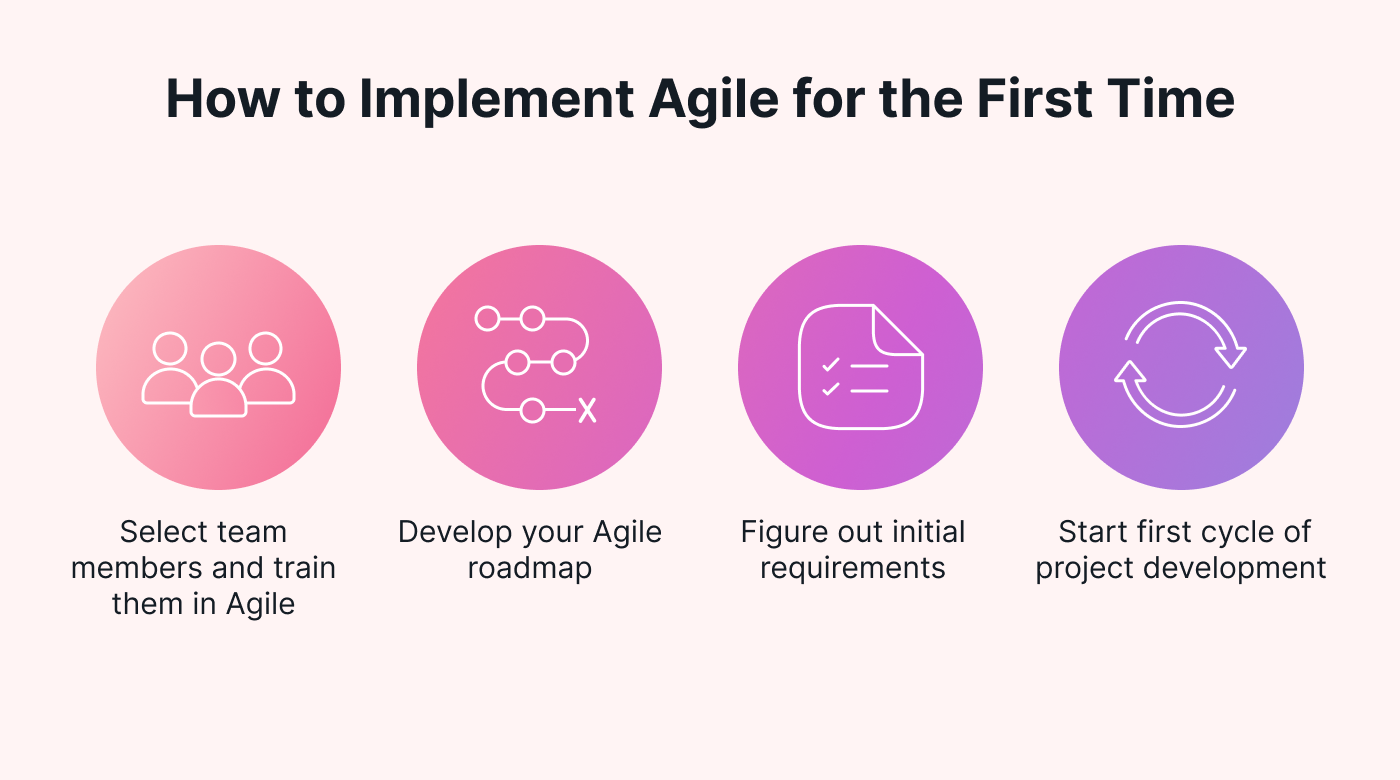 |
The first step is to assemble your team.
1. Select team members and train them in your Agile framework
Since one of the principles of Agile is to avoid top-down decision-making, the first order of action (before you start planning the specifics of the project plan) is to get the team together.
The size of the team depends on the framework you choose and the scope and requirements of your project. For example, Scrum has a maximum limit of nine team members. This is enough for rebranding a client’s website, but too few for an engineering project like building a new bridge.
You must assign roles and responsibilities once you’ve selected the project team. Plus, if anyone isn’t familiar with your Agile framework of choice, you must train them. (Don’t assign this as extracurricular homework. Arrange a workshop and make sure everyone is engaged.)
2. Develop your Agile roadmap or product backlog
An Agile roadmap or product roadmap is a document where you outline the high-level goals of your project.
Make sure this is a democratic process, not something key stakeholders like a CEO or VP of sales decide independently. Employees who work directly with customers will be more familiar with their goals and should have input here.
3. Figure out the initial requirements
This stage is where it’s crucial to listen to domain experts. A project manager (or Scrum master) alone will struggle to figure out the ideal hierarchy of dependent goals and milestones.
In Scrum, this is where your team would consider a “product backlog” — breaking the larger product into smaller deliverables from the perspective of the end user.
4. Start the first cycle of project development
This should happen quickly, as two of the core principles of Agile are speed and adapting to changing requirements. You’re not trying to predict every requirement or accurately timeline or budget the entire project before you begin.
You plan out an achievable “release” that’ll help you get a better grip on the scope of the entire project, and then your team gets to work.
5. Review, and iterate, iterate, iterate
Once you’ve finished your first cycle, review your progress. Consider anything changed — scope, customer priorities, and task dependencies.
Then, you plan your next release. And repeat — repeatedly (pun intended).
Use Motion for effortless Agile planning
Even if you understand Agile in theory, implementing it can be tricky. Luckily, Motion can help you take your project planning to the next level.
Motion makes implementing Agile principles easy. It shows everyone when tasks are scheduled, and which teammates are running ahead or behind schedule. Motion can even automatically assign tasks in your sprint backlog (based on categories and priority) to maximize your Agile team's output.
Sign up for a free trial today to experience how it can speed up your Agile workflow and increase project visibility.


